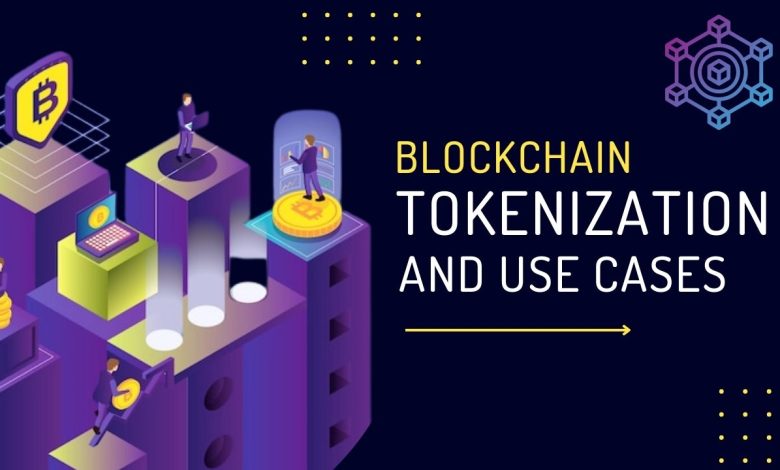What is Blockchain Tokenization and Its Use Cases?

Enterprises and businesses are exploring different ways to integrate blockchain services. According to a survey done by Deloitte, 95% of enterprises indicated numerous possibilities for investment in blockchain technology in 2022.
This percentage represents that the world is moving towards smarter business processing methods. Reasons for stability and security keep many companies at bay from investing in different blockchain solutions.
However, enterprises are aware of the significance and millions of possibilities blockchain solutions can deliver. Let us find out about what blockchain is and what is blockchain tokenization is and use its case to understand it better.
What is blockchain tokenization?
The process of converting the rights of any valued asset, such as a painting or NFT (others), into a digital token is called Blockchain tokenization.
What do these Blockchain tokens represent?
Blockchain has made the management of digital assets more accessible. Blockchain tokens are primarily paid in settlements between two (or more) participants. The tokens are created to secure valuable assets safe and secure digitally. And these blockchain tokens represent digital ownership of anything valuable.
These tokens can also manage and represent third-party ownership of an individual asset, like a work of art (or a photograph or a brand logo), and make the exchange of ownership in a blockchain network easy.
According to IDC, by the end of 2025, the worldwide tokenized assets market can reach up to $500 billion.
Using these tokens with ease and interoperability of networks across different industries has opened new ways of business development. No doubt, using digital assets and currency can give businesses of any size new opportunities to improve their processes. And when this happens, new technology, development in different sectors, and a good GDP are bound to occur.
The effect of using blockchain tokens can be seen with Inter Work Alliance (IWA), an association of industry leaders, academics, and government working towards developing a governance framework surrounding tokens. The IWA association is one step ahead with blockchain tokenization and is a source of inspiration as well.
They introduced a taxonomy named Token Taxonomy Framework (TTF). This taxonomy offers a common language known as a token formula; now, what is this language used for? This language is used to communicate a token’s properties and capabilities. Now, TTF enables the creation of standardized tokens that offer platforms and are technology-neutral, thus allowing tokens to be used across various blockchain networks.
How are these Blockchain Tokenization minted?
Tokens need to be minted to do their work. With enterprises, tokens are minted based on their capabilities and after verifying their proof of possession. As these tokens might be used later for blockchain services, companies do background checks for every asset they might come across. The number of tokens minted largely depends on the asset’s value. After these tokens are minted, they can be assigned, transferred, redeemed, and used as a payment- whatever the use is based on their use case.
Use Cases of Tokenization
Discover how blockchain tokens are utilized in different sectors;
-
Tokenization of Real Estate Assets
Real estate is the fastest-growing sector, and the usage of blockchain is another proof of this fact. People tokenize their assets to make property sales easier. Blockchain tokens are established and assigned to users that represent their ownership of an existing real estate property.
You can use blockchain services if you wish to create a digital asset for your property. Assigning tokens eliminates the need for paperwork, thus making property transfer more accessible, faster, and saving valuable time. It also means buyers and sellers have deals using only digital assets.
The tokenization in real estate would increase returns. A New York-based asset management company successfully sold real estate based on tokenization in 2018. The company sold the place in Aspen, Colorado, with a total value of 18 million dollars on the Ethereum blockchain.
-
Art and Music Tokenization
Artists, painters, and musicians are investing in blockchain tokenization to secure and sell their digital assets digitally. This way, an artist gets full ownership of their art without any chance of copying or stealing. Not only with blockchain secure their craft, but it gives it an identity. Along with art or songs, there is high demand for NFTs from digital artists. One can earn a good income by investing in blockchain; for services, you can contact a blockchain agency.
-
Tokenization of Precious Metals
Gold is probably the most adored and precious metal; people wear gold jewelry for weddings or celebrations. Moving and storing gold is a task; people use bank gold to keep their jewelry safe and secure. With technological advancement, one can now invest in blockchain to keep their jewelry intact.
Blockchain tokenization can reduce entry barriers, thus empowering small businesses to access new markets. Tokenization leads to the benefit of complete functionalization. Subsequently, tokenization use cases for the precious market and enough market participation can improve market liquidity.
The more significant number of participants also hints at the increased need for improvement in how the market works. The need for liquidity and modern solutions directly implies a dire need for the evolution of multilateral trades. Blockchain tokenization support for smart contracts could ensure the settlement of complicated part trades. Blockchain LMS can again bring the education sector to the front to cause vital changes and advancements.
-
Non-fungible Tokens
Non-fungible tokens are probably the most famous example of blockchain tokenization. NFTs are suitable for tokenization with smaller assets. For instance, owning a single piece of art in the real world is not easy, probably due to its cultural or historical significance.
Digital art is one of the most promising use cases for NFTs at the present moment. With the help of blockchain technology and cryptography, it gets accessible digital proof regarding an NFT’s authenticity and scarcity.
To Conclude
The use case of blockchain tokenization shows tremendous potential growth for every industry. While tokenization elevates the profile of the average business owner or investor, it also gives long-term benefits. Small businesses or investors use the money derived from tokens to transform their business digitally. Tokenization can also push the development of new platforms and collaborations with other investors from different parts of the world.



